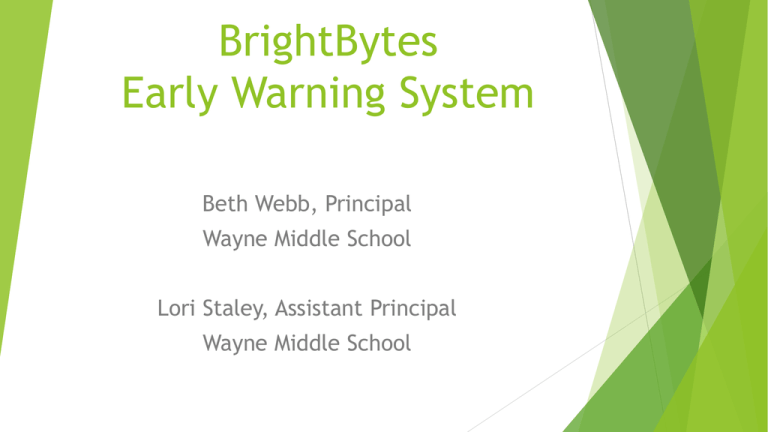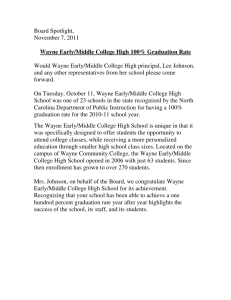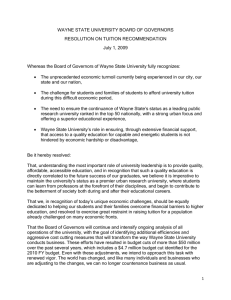BrightBytes Early Warning System Beth Webb, Principal Wayne Middle School
advertisement

BrightBytes Early Warning System Beth Webb, Principal Wayne Middle School Lori Staley, Assistant Principal Wayne Middle School Who we are… Beth Webb – Taught English 10, 11 and AP English 10 Marsh Fork High School, Raleigh County (2 years) Taught Title I Reading / 8th Grade Reading Wayne Middle School, Wayne County (7 years) Taught English 9 & 10 Spring Valley High School, Wayne County (1 year) Taught English 9, 10 and Honors English 10 Wayne High School, Wayne County (1 year) Assistant Principal Wayne Middle School, Wayne County (3 years) Principal Wayne Middle School, Wayne County (3 years) Lori Staley – Taught English 9, 10, and Honors English 9 (1 year) Taught Language Arts 6, 7, 8 and yearbook Wayne Middle School, Wayne County (4 years) Taught English 9, 10, 11, 12, and Honors English 9 Wayne High School, Wayne County (5 years) Assistant Principal Wayne Middle School, Wayne County (1 year) Our school… 550 students – 6th through 8th 5 feeder schools Low SES (approximately 45% directly qualify) No Title I funding High teacher turnover (approximately 33% annually) Entering 3rd year of Priority School Status Putting the system’s use in perspective I. District Level Considerations Identifying schools with academic and / or attendance issues Quick rewards versus game changers II. School Level Administrative / Counselor Considerations Identify specific students with truancy issues Identify specific students with behavioral / social issues Identify specific students with academic issues III. Impact on Scheduling, Curriculum, and Teaching Creating flexible schedules and structures for SPL Meeting the academic needs of the bottom 25% District considerations District level personnel have access to every school in the district and can drill down to specific schools as needed. Information is key to resource allocation and strategic planning. Provides a platform that is objective for conversations with committees and schools. Reports are customizable to allow data to reflect general overviews or specific targets. Quick Rewards Versus Game Changers One of the strengths of the data results is the generation of strategies for quick rewards and game changers. Eliminates the “we’ve tried everything” mentality. School Level Administrative Considerations Identify specific students with truancy issues Quick wins Connect Hold back to school workshops for parents Create Reach Game frequently absent students with an adult mentor school-wide incentives for attendance out in September Changers Set the standard for attendance through lessons and consistency in policies Create a family-school communication plan School Level Administrator / Counselor Considerations Identify students with behavioral / social issues Incorporate Reach Set clear transitions out to parents a positive classroom tone Help your students focus Reconfigure Prepare Focus your classroom students by teaching good citizenship on interpersonal skills School Level Academic Considerations Closing the achievement gap by identifying students with specific academic issues Academic data, such as test scores, one consideration in the Early Warn system. Two supplemental sources of information used to identify the specific academic needs of students. Benchmark scores Report with average of all tests taken Report with individual test records Standards based report Teacher recommendation Impact on Scheduling Resource Management and Priorities Targeting a changing bottom 25% Flexibility important as student needs change to minimize disruption to their schedule of core classes Not all students will need to remain in targeted SPL New at risk students will be identified throughout the year Teacher Active communication monitoring Impact on Curriculum and Teaching Meeting the academic needs of the bottom 25% to close the achievement gap Through data analysis, needed basic skills embedded in Next Generation standards addressed in targeted SPL classes Needs met in core and related arts classes through communication Conversations in grade level and curricular meetings Meetings facilitates collaborative efforts for continued progress toward closing achievement gap Discussions lead to increased use of best practices and overall student successes Summary Districts Use for identifying areas of concern for the district and individual schools Objective data for justification of resource allocation Platform for difficult conversations Identify areas of need Academics Attendance Behavior Schools Use for identifying students with difficulty Use in planning School level initiatives Classroom interventions Curriculum development Identifying students in critical areas for SPL and counseling services



